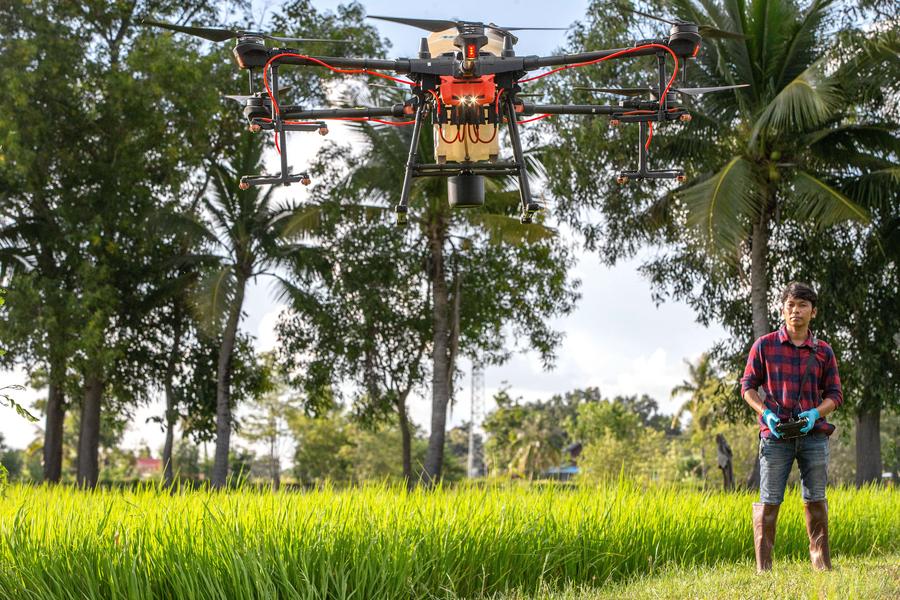
Editor’s note: Belunn Se, a special commentator on current affairs for CGTN, is a senior industry observer based in Shenzhen, China. The article reflects the author’s opinions and not necessarily the views of CGTN.
In a bold move against U.S. government sanctions, Chinese drone giant DJI has filed a lawsuit against the Department of Defense. This legal battle, which stems from DJI’s inclusion on the U.S. Entity List, has far-reaching implications for the global drone industry and the broader China-U.S. technological rivalry. As the world’s leading consumer drone manufacturer, DJI’s legal challenge underscores the growing tensions between the two superpowers and the strategic importance of emerging technologies.
Despite facing multiple rounds of U.S. sanctions and increased tariffs, DJI’s market position remains remarkably robust. This resilience stems from DJI’s fundamental competitive advantages and technological leadership in the civilian drone market.
DJI’s products have become deeply integrated into various sectors of the U.S. economy, from individual consumers to major industrial applications in agriculture, rail transportation, and corporate operations. The company’s comprehensive ecosystem and technological superiority have made it an indispensable provider of drone solutions across multiple industries.
The company’s confidence in filing a lawsuit against the U.S. Department of Defense is built on its strong foundation of independent research and development capabilities. DJI has achieved self-sufficiency in critical drone technologies, including flight control systems, safety mechanisms, and gimbal structures. This technological independence, coupled with access to China’s robust supply chain, has enabled DJI to develop a unique and globally leading hardware-software ecosystem.

China’s global supply chain model exemplifies a robust division of labor, leveraging economies of scale, cost advantages, reform and opening up, and a transition from labor-intensive to technology- and capital-intensive industries. This model allows for innovative and globally competitive technology and product offerings, which fuel a positive cycle of competitiveness and R&D reinvestment. In consumer electronics, the United States has Apple, while China has Huawei. In consumer drones, DJI stands out globally.
DJI currently leads the civilian drone market, occupying over 80 percent globally. Its applications range from agricultural monitoring and goods transportation to aerial photography. DJI’s impact extends beyond technology, shaping daily life and advancing human capabilities.
Drones are divided into military and civilian classifications, with civilian drones further split into consumer and industrial segments. Industrial drones are essential in sectors such as agriculture, power line inspections, aerial surveying, and disaster relief.
The demand for military drones has surged in recent years, driven by evolving warfare dynamics and heightened security concerns. By 2028, the global military drone market is anticipated to reach an output value of approximately $18 billion.
In the civilian sector, the market exceeded 160 billion yuan in 2021, with industrial drones accounting for about 60 percent of this figure. Projections indicate that by 2025, the civilian drone market could reach 500 billion yuan, with industrial drones increasing their share to 80 percent.
The drone system comprises several components: the flight platform, power systems, avionics, payload systems, ground systems, and comprehensive support systems, with the flight platform serving as the system’s core. China’s drone industry boasts a robust supply chain, covering everything from raw materials to final assembly, ensuring comprehensive integration and efficiency.
The lawsuit against the U.S. Department of Defense represents more than just a legal challenge; it symbolizes the evolving nature of China-U.S. technological competition. What began as market competition has transformed into a complex interplay of economic and political factors, with significant implications for global technological development.
The confrontation between DJI and the U.S. Department of Defense highlights the broader challenges facing Chinese technology companies in an increasingly complex global environment. While U.S. sanctions may escalate tensions in bilateral relations, they are also likely to accelerate China’s investment in drone technology research and development.
DJI’s legal action not only serves to protect its own interests but also sets a precedent for the entire Chinese drone industry. As global demand for drone technology continues to rise, the ability of Chinese companies to navigate international competition while maintaining technological leadership will be crucial for the industry’s future development.
The company’s continued success in the face of international challenges demonstrates the resilience of China’s technological ecosystem and its capacity for independent innovation. As the drone industry evolves, DJI’s experience may serve as a model for other Chinese technology companies facing similar challenges in the global marketplace.
(If you want to contribute and have specific expertise, please contact us at opinions@cgtn.com. Follow @thouse_opinions on X, formerly Twitter, to discover the latest commentaries in the CGTN Opinion Section.)
